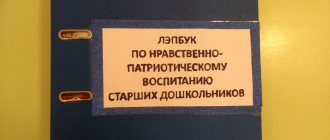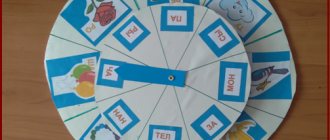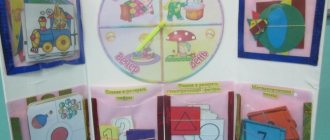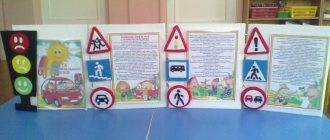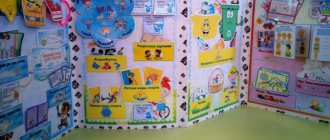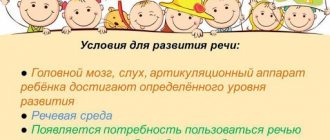The structure of the lesson in accordance with the Federal State Educational Standard. Educational and methodological manual on the topic
MBDOO No. 11 “Kindergarten “Cornflower”, Dondukovskaya village”
Practical advice for conducting classes on Federal State Educational Standards for Preschool Education
- Think through the organization of children in the classroom (alternating different types of children’s activities: sitting, standing, on the carpet, in groups, in pairs, etc.)
- High-quality preparation of visual materials for the lesson (accessibility to every child, modernity, quality and size of illustrations, multimedia presentations can be shown)
- Compliance with the structure of the lesson:
- Introductory part (creating motivation and “not forgetting” about it throughout the entire lesson. For example, if Dunno came, it means that throughout the lesson he “participates” in activities with children, at the end of the lesson you can sum up the results on behalf of the character)
- Also, in the first part of the GCD, it is necessary to create a problem situation (or a problem-search situation) for children, the solution to which they will find throughout the entire event. This technique allows preschoolers not to lose interest, develops mental activity, and teaches children to interact in a team or in pairs.
- During the main part, the teacher can use various management techniques: visual, practical and verbal, allowing him to solve the program tasks of the lesson and the assigned problem-search situations.
- After each type of children’s activity, the teacher must conduct an analysis of the children’s activities (either on his own behalf, or on behalf of the character or with the help of other children) - this is a requirement
- In cases where something is not working out for children, the teacher can use a technique such as pedagogical support. For example, the teacher says: “I really liked how Seryozha, Marina and Lena made the traffic light, but Maxim and Oleg’s parts came off, but I think that next time they will definitely try and do everything well”)
- Throughout the entire lesson (especially in groups of senior preschool age), the teacher must monitor and encourage children to engage in speech activity with the help of questions. Therefore, questions for children must be thought out in advance; they must be exploratory or problematic in nature; strive to ensure that children answer “completely.” You also need to control your own speech and construct speech phrases in the third person. For example, moving away from the expression: “I want to invite you on a trip...” is not correct, because... the teacher seems to “impose” the upcoming activity. It would be more correct to address the children in this way: “Let's go on a trip...”
- Also, in accordance with new educational standards, a teacher can use pedagogical technologies: problem-based learning, research activities, project activities, health-saving technologies, and more. (Depending on their type of children's activity and on the assigned tasks in the lesson) For example, during a lesson on cognitive development in the second junior group “Visiting the Cockerel”, the teacher can conduct articulatory gymnastics to develop breathing, etc.
- The final part of the lesson should be organized in such a way that the solution to the problem and search situation can be traced (so that children see the solution to the task: either a verbal conclusion, or the result of productive or research activity, etc.).
- It is also necessary to summarize the entire lesson: evaluate the children’s activities (you can use pedagogical support, analyze each other’s children, themselves, praise the children on behalf of the character, etc.). The main thing is not to forget about motivation (which is set at the beginning of the lesson, see point above)
4. A distinctive feature of classes in the Federal State Educational Standard for Preschool Education is the active speech activity of children (questions to children should be of a problem-searching nature), and also carefully thought out.
For example, children need to help the Chicken find chickens. The teacher may ask: “Do you want to help the Hen find the chickens? How can this be done? That is, the question is problematic in nature and forces children to think through possible answers: call the chickens, follow them, etc.
5. The teacher is simply obliged to provide children with “freedom of choice” for upcoming activities and, at the same time, to captivate children with their skill. For example, during an educational lesson, the teacher of the first junior group told the children the fairy tale “Kolobok”, and then offered motivation for the upcoming activity (collective application of the character Kolobok)
“Guys, Kolobok ran away from his grandparents, they are crying bitterly. How can we help our grandparents? Then he offers possible answers: maybe we should draw a Kolobok and give it to our grandparents? Thus, she captivated the children, organized motivation for drawing, got them interested, and also solved the educational task: to make the children want to help their grandparents in finding Kolobok.
Thus, it should be concluded that currently the requirements for conducting classes have changed, because there are pedagogical technologies that must be used in the implementation of the Federal State Educational Standard for Education
The structure of writing a GCD summary in a preschool educational institution according to the Federal State Educational Standard
Municipal budgetary preschool educational institution
Kindergarten No. 12 “Bell”
Consultation for teachers
The structure of writing a GCD summary in a preschool educational institution according to the Federal State Educational Standard
The structure of writing a GCD summary in a preschool educational institution according to the Federal State Educational Standard
With the introduction of the Federal State Educational Standard, the approach to organizing and conducting direct educational activities with children is changing.
There is a rejection of traditional classes built in the logic of the educational model. The lesson is understood as an exciting activity with children, during which the teacher solves program problems. The role of the teacher is being rethought, becoming more of a “coordinator” or “mentor” than a direct source of information.
The position of a preschool teacher in relation to children changes and takes on the nature of cooperation when the child acts as an equal partner in a situation of joint activity and communication with the teacher.
Many teachers do not pay attention to the design of notes. The topic, purpose, and objectives are written in the notes. And often tasks pass through the goal.
Let's remember how this is done.
Let's start with the title page
The full name of the preschool institution is indicated at the top of the title page. Approximately in the middle of the sheet there is an inscription:
Abstract
Direct educational activities in (Region)
On the topic of: "……………"
for older children.
Below the title of the abstract, the author's surname and position are indicated on the right.
At the end of the title page, in the middle, your locality is written, and even lower, the year when the summary was written.
Next sheet
starts with program content.
This includes the purpose and objectives of the GCD.
What is a goal?
The goal is the end result, what we strive for. The goal is achieved through tasks, which in relation to the goal are means, i.e. how we will achieve this goal. It is recommended that the goal be determined by a noun from a verb: creating conditions, forming, educating, strengthening, etc.
Goal setting algorithm:
- Assess the existing problems and identify the main one, clearly formulate it.
- Determine the steps (actions) to solve it and their sequence.
- Formulate exactly the intermediate result (effect) from the execution of each step (action).
- Evaluate which (and how many) of these steps (actions) can be carried out within the framework of one GCD.
- Formulate the goal of the GCD, which contains a description of the effect of the actions that you plan to carry out within the framework of one GCD.
What an adult proposes to do must be necessary and interesting for the child, and the meaningfulness for the child of the activity proposed by the adult is the main guarantee of the developmental effect.
A task
is something that requires execution or solution.
Tasks in relation to the goal are and are:
Educational;
Developmental;
Educating.
It is recommended to formulate tasks with a verb in an indefinite form: consolidate, generalize, form, develop, educate, etc. Maintain clarity and specificity in the formulation of tasks (not just expand (consolidate) ideas about winter, but what exactly children learn (reinforce) about winter within the framework of this lesson). This also applies to the formulation of developmental tasks: not just the development of children’s mental abilities, but which ones specifically (list).
It should be remembered that each new task is written on a new line.
When the tasks are formulated, it is necessary to indicate what equipment
will be used on this GCD (for example: tape recorder, board, easel, wall board, cubes, stands, etc.).
The following is the demonstration material:
where not only all manuals and paintings are listed, but also their authors, quantity, and sizes are indicated.
Describing the handout material,
It is necessary to list what material is taken, indicating the size and quantity.
Next, it is necessary to describe the teacher’s previous work
in preparation for the lesson:
what was designed, what was produced, what was compiled, studied, written, etc. After this, preliminary work with children
, the entire scope of frontal and individual work with children (where they went on an excursion, what object they observed, what they read to the children, what they learned, etc.)
After this, it is written what individual work,
with whom (indicate the names and surnames of the children) in what part of the lesson it is planned to take place.
It is advisable not to forget to include this work in the part of the lesson in the notes in which you planned.
The following describes the structure
and
methodological techniques
used in the lesson.
The parts of the lesson and specific methodological techniques are indicated.
The summary also includes vocabulary work.
- these are new words, the meaning of which must be explained to children.
The parts of the lesson and specific teaching techniques are indicated.
.
The following describes the organization of children in direct educational activities.
The placement of tables, equipment, seating and placement of children is indicated - if necessary, a placement plan is included.
If the placement of children in different parts of the lesson changes, describe how the transition from one part of the lesson to another is carried out. And finally, a description of the course of the lesson
.
The course of the lesson is written in direct speech. Be sure to write down all the words that the teacher will say, the expected answers of the children, and the teacher’s generalizations.
If during the lesson the teacher needs to perform some actions, this is indicated in the notes. The lesson ends with words of analysis.
So, if we briefly describe all of the above,
the structure of the abstract is as follows:
- Type, type, topic of GCD indicating the age group of children
- Program content
(training, developing, educating tasks).
- Vocabulary work.
- Class equipment.
- Demonstration material.
- Handout.
- Previous work of the teacher in preparation for the lesson.
- Preliminary work with children
(with the whole group, with a subgroup, individually).
- Individual work with children on educational activities
(which one, with whom, in what part of the lesson).
- Lesson structure and methodological techniques.
- Organization of children in the classroom.
- Progress of the lesson (in direct speech).
At the end there are final phrases or analysis of the lesson.
We remind you about the types of classes:
1. Classes on communicating new knowledge. 2. Classes to consolidate knowledge, skills and abilities. 3. Lessons on generalization and systematization. 4. Final. 5.Accounting and verification. 6. Combined (mixed, combined). 7. Complex. 8. Integrated
(based on the principle of combining several types of children's activities and different means of speech development).
Integration can be on a thematic basis.
For example:
1) reading about birds; 2) collective drawing of birds; 3) storytelling based on pictures.
Additional Information
Do not forget about the methodological support of the pedagogical process. Any activity begins with a motive.
Motive
is a reason that motivates action. Previously, we called a motive a moment of interest before a lesson.
The following motives for activities for children are distinguished:
Gaming.
A child can realize his need for significance by “helping” various toys solve their practical and intellectual problems.
Motivation for communication.
Motivation is based on the child’s desire to feel necessary and important in helping an adult. An adult turns to a child with a request to help him, he says that there is no way to do without the child’s help. At the same time, he does not forget to thank the child.
Self-interest motivation.
This motivation encourages the child to create various objects for his own consumption.
After motivation comes the methodology for conducting the lesson. This section should highlight the parts of the lesson. Children's answers are not written in notes.
Lesson structure according to Federal State Educational Standards
| Lesson steps | Summary, student actions | Teacher's actions |
| Motivation for educational activities | Creating a favorable lesson atmosphere and focus on work | Sets students up for success |
| Updating knowledge | Repetition of what has been covered, completion of tasks. Peer review and evaluation Then students receive a task for which their existing skills are not sufficient | Consults |
| Goal setting, problem statement | In joint work, the causes of the difficulty are identified and the problem is clarified. Students independently formulate the topic and purpose | Leads students to defining the boundaries of knowledge and ignorance, understanding the topic, goals and objectives of the lesson. |
| Finding ways to solve the problem | Planning ways to achieve the intended goal. Carrying out training activities according to plan. Individual or group work to solve practical problems | Consults |
| Solution | Perform a task that at first turned out to be too difficult to solve | Consults |
| Correction | They check the solution, determine whether everyone has completed the task, and formulate difficulties | Helps, advises, advises |
| Independent work using acquired knowledge | Performing exercises on a new topic, self-test according to the standard | Consults |
| Systematization of knowledge | Work to identify the connection between the topic studied in class and previously studied material, connections with life | Consults, guides |
| Homework explanation | Students should have the opportunity to choose homework according to their preferences. It is necessary to have tasks of different difficulty levels | Explains, offers tasks to choose from |
| Assessment | Students independently evaluate their work (self-assessment, mutual assessment of classmates’ work results) | Consults, substantiates assessments |
| Reflection on learning activities | Students name the topic of the lesson, its stages, list the types of activities at each stage, and determine the subject content. Share opinions about their work in class | Thanks students for the lesson |
The structure of a lesson on “discovering” new knowledge according to the Federal State Educational Standard
- Motivation for educational activities . The student must consciously enter into learning activities. To do this, the teacher must create conditions when the student understands the requirements for him in the lesson, feels the desire to get involved in the work and believes that he is capable of learning activities.
- Updating knowledge . Students are prepared for proper independent implementation of a trial learning activity. While completing assignments, students record their difficulties.
- Identifying the location and cause of the difficulty . Under the guidance of the teacher, students restore the order of the actions taken and determine the specific location of the difficulty. By comparing their actions with the method (algorithm) used, students determine the cause of the difficulty - specific knowledge and skills that do not yet exist to solve the problem. It is very important to say all actions out loud.
- Building a project to solve a problem . Students think about and discuss their future learning activities: set a goal (eliminating a difficulty), determine the topic of the lesson, choose a method, build a plan to achieve the goal and select means. The teacher leads through suggestive or stimulating dialogue or through investigative methods. The choice of a specific method depends primarily on the degree of preparedness of the class.
- Project implementation . By discussing the various options proposed by students, the optimal course of action is selected and used to solve the original problem that caused the difficulty. At the same time, the teacher must quietly lead the students to the correct method. After solving the problem, students note that they have overcome a previously encountered difficulty and express the idea that this method is suitable for solving similar problems.
- Primary consolidation . Students solve standard tasks on a new method of action, saying the solution algorithm out loud. In this case, work can be carried out frontally, in groups or in pairs.
- Independent work with self-test according to the standard . Students are already independently completing tasks of a new type and checking the correctness of the solution themselves, comparing it with the standard. After this, the results are discussed. It is advisable to create a situation of success for every child.
- Inclusion in the knowledge system and repetition . It is determined when new knowledge can be applied and how it may be useful in the future. Tasks are given where the developed method of action is provided as an intermediate step.
- Reflection on learning activities in the classroom . Students remind themselves of new content learned in class. Self-analysis and self-assessment of students’ educational activities are organized. Conclusions are drawn about the achievement of the goal set at the beginning of the lesson.
Structure of developmental control lessons
This type of lessons can be compared to traditional lessons, when tests are carried out first, and in the next lesson, mistakes are worked on. The fundamental difference is that in these lessons the emphasis is on self-control, on the development of self-analysis in students. In such lessons, students continue to develop their control and assessment abilities. They are carried out after studying a large block of material and take two hours, so they are more often used in teaching subjects such as mathematics, Russian, and physics.
Developmental control lessons consist of the following stages.
| 1 lesson | Motivation for control and corrective actions | It is required that students prepare for the test, understand its necessity, and feel confident. |
| Update and trial action | Knowledge on the topic is being updated. Control work is being carried out. Then a self-test is carried out against the standard. Students check their work and grade themselves, but do not correct mistakes. | |
| In the interval between two lessons, the teacher himself checks the work and gives grades for them. | ||
| Lesson 2 | Localization of difficulties | Students identify their mistakes and difficulties. |
| Goal setting and construction of a plan for correcting identified difficulties | Students must choose individual goals for themselves and determine means and ways to solve difficulties. | |
| Project implementation | Students work on a draft. For those who have made the same mistakes, work in groups is possible. | |
| Summary of Difficulties | The difficulties, the chosen ways to resolve them, and the solution algorithm must be discussed. Explain why they chose this particular path. | |
| Independent work with checking against the standard | Students work independently on those tasks for which difficulties arise. They check the sample and answer the question whether the difficulties have been resolved, whether the errors have been corrected. | |
| Inclusion in the knowledge system | To consolidate the acquired knowledge, tasks similar to the previous ones are performed, but more creative. | |
| Reflection | Students analyze their work in class. If necessary, homework is given. | |
Structure of different types of lessons
Lessons on the Federal State Educational Standard are based on a system-activity approach. Such lessons can be divided into the following types:
- lessons of introduction (“discovery”) of new knowledge (ONZ);
- reflection lessons;
- lessons of general methodological orientation;
- lessons of developmental control.
The structure of a lesson according to the Federal State Educational Standard may differ slightly. For example, in EHS lessons there may be no stage of checking homework completion. There will be no learning of new material during reflection lessons. All stages are most fully traced in lessons with a general methodological orientation.
